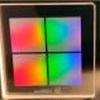Optica, formerly OSA, reports that researchers have developed "5D" data storage technology that might allow 500 terabytes of data to be stored on a CD-sized glass disc. The technique was developed using high-speed lasers.
The technique makes use of faster writing speeds, which may one day make it practical to employ the technology for archival and other applications, among other things. With 5D optical storage, each file is stored on three layers of nanoscale dots, one on top of the other. The five "dimensions" are made up of the size, orientation, and position of the dots within the three conventional dimensions, all of which are different. Using a microscope and a polarizer, the dots alter the polarization of light traveling through the disc, which is read by the computer.
Although 5D optical data storage in transparent materials has been demonstrated before, writing data fast enough and with a high enough density for real-world applications has proved challenging. To overcome this hurdle, the researchers used a femtosecond laser with a high repetition rate to create tiny pits containing a single nanolamella-like structure measuring just 500 by 50 nanometers each.
Rather than using the femtosecond laser to write directly in the glass, the researchers harnessed the light to produce an optical phenomenon known as near-field enhancement, in which a nanolamella-like structure is created by a few weak light pulses, from an isotropic nanovoid generated by a single pulse microexplosion. Using near-field enhancement to make the nanostructures minimized the thermal damage that has been problematic for other approaches that use high-repetition-rate lasers.
Because the nanostructures are anisotropic, they produce birefringence that can be characterized by the light’s slow axis orientation (4th dimension, corresponding to the orientation of the nanolamella-like structure) and strength of retardance (5th dimension, defined by the size of nanostructure). As data is recorded into the glass, the slow axis orientation and strength of retardance can be controlled by the polarization and intensity of light, respectively.
“This new approach improves the data writing speed to a practical level, so we can write tens of gigabytes of data in a reasonable time,” said Lei. “The highly localized, precision nanostructures enable a higher data capacity because more voxels can be written in a unit volume. In addition, using pulsed light reduces the energy needed for writing.”
500TB of data can be stored on a CD-sized glass disc using 5D storage technology


